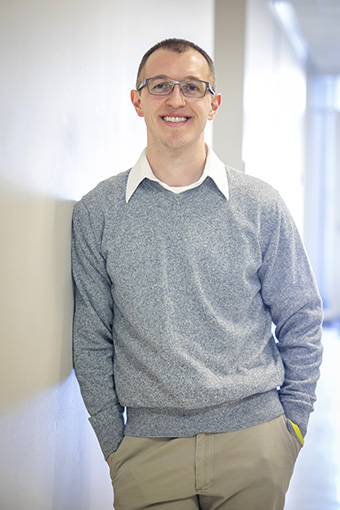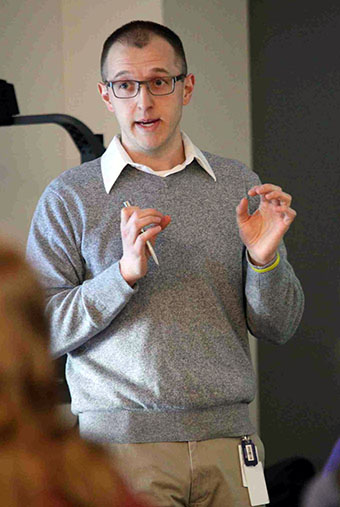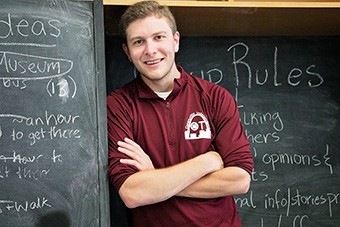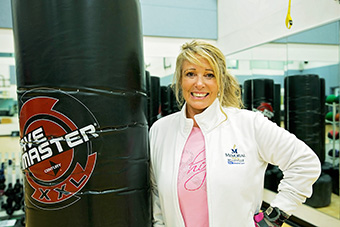Biopsychology Major Prepares Students for a Variety of Careers
by Alec De Yong ’20
(Alec De Yong ’20 is a senior professional writing and rhetoric major in the honors program.)
At less than four years old, McKendree’s biopsychology program is sending graduates into the world well equipped to succeed in their field. With
approximately 60 students, “it is already very popular and many have gone on to occupational
or physical therapy graduate school, counseling programs and careers,” said Dr. Tami
Eggleston, professor of psychology and a driving force behind the program’s creation.
The relatively young program was created as Tami (who graduated with a biopsychology
degree herself) saw she was helping many students gain footing in occupational therapy,
physical therapy, accelerated nursing and chiropractic—fields which required some psychology classes as well as biology classes. “We wanted to offer a major that truly is the
best of psychology and the best of biology,” she said.
The degree allows graduates to stand out as they take their next step after McKendree.
“Gaining acceptance into graduate schools is very competitive,” noted Tami, who wants
the program’s graduates to have every possible advantage. The program is popular among
students and many graduates have already gone on to do big things, she said. “We are
meeting the students’ goals. I feel very proud of what they have already accomplished
and just this year we have had many get accepted into graduate programs.”
Dr. Angela LaMora, assistant professor of biology, oversees the science courses required
for biopsychology. “We will be further differentiating the BS and BA degrees, emphasizing
the biological sciences with the BS,” she said. Students who are strong in biology
“can concentrate on this core of classes, allowing them to maintain high GPAs while
getting to take the exact courses they need.”
Both professors hope to see the major continue to grow, with more student research
projects and biopsychology-related internships. This summer, the program welcomed
Dr. Michael Hahn, who is eager to conduct research with the students. “We have accomplished
a lot in just four years, so I feel confident that our biopsychology major will continue
to thrive,” said Tami.
In these articles, you will meet an Alzheimer’s researcher, an occupational therapist,
and a fitness coach who works with Parkinson’s patients—three alumni who have shared
their expertise, training and skills to inform and inspire students in the biopsychology
capstone class.
FAMILY CONNECTIONS INSPIRE NEUROSCIENTIST’S RESEARCH
As a member of the McKendree Bearcat men’s bowling and ice hockey teams, Tom Mahan ’07 developed leadership experience and a sense of teamwork—skills he continues to utilize
today as a research assistant and doctoral candidate on the frontier of Alzheimer’s
research.
Tom’s path from student-athlete to researcher began as a biology major in Voigt Hall. “My time spent at McKendree helped lay the groundwork for my interest
in how biological systems work,” he said. His McKendree education provided a knowledge
base to build upon in postgraduate school, helping him to develop critical thinking
skills and to “think like a scientist.”
Dr. Robb Van Putte, professor of biology, served as a mentor for Tom’s senior research
project and his first venture into conducting original research. “When I faced challenges
in my research project, Dr. Van Putte reassured me that even though experiments may
not go according to plan, it was all part of the scientific learning process,” Tom
said.
“THESE PROTEIN AGGREGATES ARE ULTIMATELY WHAT LEAD TO THE DEMENTIA AND COGNITIVE IMPAIRMENTS
THAT ARE SEEN IN ALZHEIMER’S.”
Shortly after he graduated from McKendree, Tom began pursuing his master’s degree
by taking night classes at the University of Missouri–St. Louis. A course in Proteins
as Polymers introduced him to Alzheimer’s disease and has helped inform his research
and aided him in developing experiments. Tom’s research is on protein collecting in
the brain and the damage it causes. “These protein aggregates are ultimately what
lead to the dementia and cognitive impairments that are seen in Alzheimer’s,” he explained. During this time, Tom’s grandmother began to develop dementia, a primary symptom of
Alzheimer’s. This tragedy, paired with his newfound awareness of Alzheimer’s, put
Tom on his current path. “I found myself asking more and more questions about Alzheimer
disease and realized that I really wanted to be involved in the scientific research
and maybe one day be involved in helping develop therapeutics,” he said.
During this time, Tom’s grandmother began to develop dementia, a primary symptom of
Alzheimer’s. This tragedy, paired with his newfound awareness of Alzheimer’s, put
Tom on his current path. “I found myself asking more and more questions about Alzheimer
disease and realized that I really wanted to be involved in the scientific research
and maybe one day be involved in helping develop therapeutics,” he said.
After obtaining his master’s, Tom began working as a research assistant at the Washington
University School of Medicine lab of Dr. David Holtzman. He started with the biochemical
analysis of mice brains, but these are no ordinary rodents. The roughly 1,000 mice
he studies are biologically engineered to produce the protein plaques that cause Alzheimer’s
much faster.
Currently a doctoral candidate, he expects to graduate in May.
Tom has another significant tether to the disease that he has spent so much time researching:
his two-year-old son, Teddy, who was born with Down syndrome. Tom explained that individuals
with Down syndrome are born with three copies of their 21st chromosome. This is also
the chromosome that produces amyloid beta, the main component of the protein plaques
that cause Alzheimer’s. Individuals with Down syndrome produce 50 percent more amyloid
beta, making them much more likely to develop Alzheimer’s. Tom shared that one in
10 individuals with Down syndrome have Alzheimer’s disease and 70 percent over age
60 have it. These numbers are staggering when compared to the general population.
“Having had elderly relatives who have been affected by Alzheimer disease, I have
experienced and seen firsthand how distressing it can be,” Tom said. “Not only is
it difficult for those diagnosed with it; it is also incredibly trying on the loved
ones and caregivers who have to watch their loved ones slowly fade away.”
“I HAD NEVER THOUGHT ABOUT WHAT IT WOULD BE LIKE FOR A PARENT TO WATCH THEIR CHILD
WITH DOWN SYNDROME DEVELOP ALZHEIMER DISEASE.” While he was previously aware of the connection between Alzheimer’s and Down syndrome,
Tom said having Teddy opened his eyes. “I had never thought about what it would be
like for a parent to watch their child with Down syndrome develop Alzheimer disease,”
he said. “My son has been such a blessing and he now provides me with an entirely
new motivation to get up every day and fight even harder to achieve a world without
Alzheimer’s.”
While he was previously aware of the connection between Alzheimer’s and Down syndrome,
Tom said having Teddy opened his eyes. “I had never thought about what it would be
like for a parent to watch their child with Down syndrome develop Alzheimer disease,”
he said. “My son has been such a blessing and he now provides me with an entirely
new motivation to get up every day and fight even harder to achieve a world without
Alzheimer’s.”
The Down syndrome-Alzheimer’s connection provides a potential wealth of knowledge
for researchers. According to Tom, Washington University has been a world leader in
developing biomarkers to help determine if someone has Alzheimer’s. Many of these
biomarkers have been developed with the help of participants who have a family history
of early or late onset Alzheimer’s. Tom elaborated that there has been a push recently
to investigate further these biomarkers in persons with Down syndrome.
The National Institutes of Health has started an initiative to study biomarkers in
individuals with Down syndrome. Universities across the U.S. and U.K. are included
and Washington University will actively recruit participants and analyze biomarkers.
While Tom is not directly involved in this research, he hopes to take part in these
efforts going forward in his career.
“Finding treatments for Alzheimer’s is going to be one of the greatest accomplishments
of our generation,” he said. “I am incredibly honored to have an opportunity to aid
in the development of treatments through my research. I hope that I can continue to
help us move towards a world without Alzheimer disease for everyone, including individuals
who have Down syndrome like my son.”
HELPING OTHERS GAIN, RESTORE OR MAINTAIN INDEPENDENCE
 After his first year at McKendree, Ronnie Drummond ’17 learned of a new degree program which would be available for the first time in the
2016-2017 school year, one that put him directly on the path he sought. Ronnie graduated
in 2017 with a bachelor’s degree in biopsychology and is slated to graduate from his
current program next spring. In April he spoke to a class of McKendree biopsychology
students.
After his first year at McKendree, Ronnie Drummond ’17 learned of a new degree program which would be available for the first time in the
2016-2017 school year, one that put him directly on the path he sought. Ronnie graduated
in 2017 with a bachelor’s degree in biopsychology and is slated to graduate from his
current program next spring. In April he spoke to a class of McKendree biopsychology
students.
It was after he completed his first year at McKendree in 2015 that Ronnie was steered
toward both occupational therapy (OT) and biopsychology for the first time. Exploring degree choices, he became intrigued
by occupational therapy, a degree unfamiliar to him. “I thought of the benefits my
dad could gain from receiving OT services,” he said. When Ronnie was young, his father
was involved in a car accident that resulted in back problems. Ronnie’s interest eventually
drove him to tour the Washington University School of Medicine. “That tour solidified
my interest in pursuing an occupational therapy degree because of my passion to make
a difference in individuals’ lives,” he said.
OT works with individuals who need help gaining, restoring or maintaining independence
in their daily lives, Ronnie explained. He has worked to make a positive and lasting
impact by “allowing individuals, no matter the diagnosis, condition or situation,
to live life to the fullest by engaging in the activities that are most meaningful
to them.”
Entering the OT program at Washington University, Ronnie was drawn to two different
research labs. One focused on the driving abilities of patients with early-onset Alzheimer’s,
which interested him. The other was directed by Dr. Quinn Tyminski, who had worked
with homeless populations for more than five years. Ronnie made his choice on the
first day as he observed Dr. Tyminski’s work at a local homeless shelter, when a client
was being housed in his own apartment. “As I watched this man break down and express
nothing but his gratitude and appreciation… I realized at that moment that I belong
serving this population,” Ronnie said.
Ronnie has participated in many programs as a student of OT and has even started one
of his own. “I developed a program to address the concerns of health management and
maintenance through six different group sessions at the clinic to address nutrition,
medication management, health hygiene, exercise, sexual health and sleep,” he explained.
He also collaborates with what he calls some of the “greatest minds in the profession”
on other programs, clinics and studies, all aimed at fulfilling his passion: helping
people do the things they want and need to do.
FIGHTING BACK AT PARKINSON’S
 Stacie (Panek) King ’14 earned a degree in health and wellness but her professional journey began long before she stepped foot on McKendree’s campus.
In the fitness business since 1982, she has made her way from working the desk at
a health club to making a difference in the lives of more than 100 people with Parkinson’s
disease. “When you’re working from one job to another in the same area, that's a pretty
good sign it's your passion,” she said.
Stacie (Panek) King ’14 earned a degree in health and wellness but her professional journey began long before she stepped foot on McKendree’s campus.
In the fitness business since 1982, she has made her way from working the desk at
a health club to making a difference in the lives of more than 100 people with Parkinson’s
disease. “When you’re working from one job to another in the same area, that's a pretty
good sign it's your passion,” she said.
As a non-traditional student with three children, Stacie was understandably intimidated
by the prospect of returning to school. She chose to attend McKendree in part because
of its small size. Her hard work, research and the public speaking skills she gained
as a student have more than paid off, she noted.
After she graduated, Stacie was hired at Memorial Hospital’s Belleville Health and
Sports Center (BHSC) and learned about Rock Steady—a nonprofit organization which
improves the quality of life of people with Parkinson’s disease through non-contact
boxing-based fitness. The program at BHSC was founded and is underwritten by Deborah
Belsheim, a McKendree donor.
W hile she has been a boxer for quite some time and has taught boxing programs before,
Stacie admitted her knowledge of the disease was nowhere near as extensive. “The only
person I knew who had Parkinson’s was my cousin and I knew nothing about Parkinson’s,”
she said.
hile she has been a boxer for quite some time and has taught boxing programs before,
Stacie admitted her knowledge of the disease was nowhere near as extensive. “The only
person I knew who had Parkinson’s was my cousin and I knew nothing about Parkinson’s,”
she said.
Three weeks into her job, she took a weekend training opportunity in Indianapolis
to become a Rock Steady-certified coach. She started the program at BHSC in June of
2016 with 48 class members. In just two years, the program has grown to more than
100.
When nerve cells die in the portion of the brain that controls movement, the brain
produces less dopamine, causing the hallmark symptoms of Parkinson’s: trembling, stiffness,
and impaired balance and coordination. Stacie’s clients start the program with focus
and hand-eye coordination. “It wakes up the muscles and things start happening,” she
said. Although the goal is to “fight back at Parkinson’s,” the curriculum does not
stop at boxing. Stacie also uses Tabata (high intensity interval) and circuit training,
free weights and scores of other workouts.
Rock Steady has given Stacie’s passion for health and fitness new life and a deeper
fulfillment. For her group members, it is not just a workout; they support each other,
they are a family, she said. Many of those she helps had, at one point, given up hope,
she noted.
“I would never give this up. This is my path. I would’ve never known that I’d be working
with Parkinson's patients. It’s just amazing. We see miracles every single day. There
is hope we can provide, that they can fight back and have some kind of quality of
life.”

